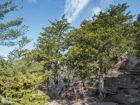
Mature trees growing on the escarpment at Devils Lake State Park, Wisconsin [C.J. Earle, 2023.05.04].

A young tree, 8 cm dbh and 6 m tall, in the understory of a hardwood forest near Tuscaloosa, Alabama [C.J. Earle, 2024.03.10].
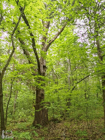
A large forest interior tree in Mark Twain National Forest, Missouri [C.J. Earle, 2023.05.11].
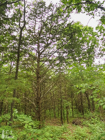
A closed-canopy stand of mixed hardwoods and J. virginiana at Runge Nature Center, Missouri [C.J. Earle, 2023.05.12].
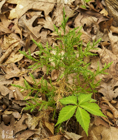
A seedling ca. 10 cm tall in Mark Twain National Forest, Missouri [C.J. Earle, 2023.05.11].
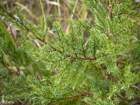
Typical juvenile foliage on at tree at Buffalo River State Park, Minnesota [C.J. Earle, 2019.09.28].

Typical adult foliage on at tree at Itasca State Park, Minnesota [C.J. Earle, 2019.09.29].
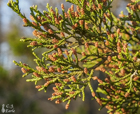
Nearly-ripe pollen cones on a tree at Lake Mineral Wells State Park, Texas [C.J. Earle, 2024.02.05].
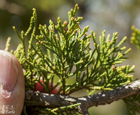
Foliage with receptive female strobili on a tree at Bluffton Natural Area, Iowa [C.J. Earle, 2023.05.03].
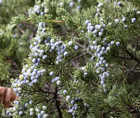
Heavy crop of seed cones on a tree at Effigy Mounds National Monument, Iowa [C.J. Earle, 2019.10.11].

Bark on a forest interior tree at Bluffton Natural Area, Iowa. The frayed character indicates that small animals have been harvesting the bark, typically for nesting material [C.J. Earle, 2019.10.11].
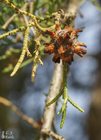
A seed cone infected by cedar apple rust, Gymnosporangium juniperi-virginianae; Arrow Rock, Missouri [C.J. Earle, 2023.05.12].
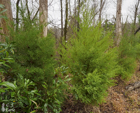
J. virginiana regeneration following overstory removal by hurricane Michael in 2018 at Torreya State Park in Florida. The left sapling has all adult foliage, the center one has all juvenile, and the one at far right has both types [C.J. Earle, 2024.02.12].

A tree along a fenceline west of Council Grove, Kansas. Through the action of birds perching on fences and utility wires, J. virginiana has extended its range far west into the Great Plains, in some areas far enough to contact J. scopulorum which has been moving eastwards by the same mechanism [C.J. Earle, 2023.05.15].

Just for fun: this car made out of J. virginiana was sold on eBay on 2010.08.16.

Conservation Status

Juniperus virginiana
Linnaeus 1753, p. 1039
Common names
Eastern redcedar, red or eastern juniper; genévrier rouge [French]; miskwaawaak [Ojibwe]. Subsp. silicicola is also known as southern redcedar, coastal redcedar, or sand cedar.
Taxonomic notes
This is one of the 9 species of Juniperus described in 1753 by Linnaeus; type USA, locality unknown, LINN 1198.7. It belongs to the North American/Caribbean subclade of the smooth-leaf-margin junipers of Section Sabina. J. virginiana anchors a large species complex. It is essentially identical to J. scopulorum. The two taxa adjoin each other in morphological, chemosystematic, and genetic analyses, and the geographic line separating them is essentially an arbitrary boundary drawn across a treeless portion of the Great Plains--a particularly arbitrary boundary in this time of climate change. In a truly objective taxonomy they would probably be different subspecies of one species. Taken together, they are the predominate juniper of North America, their distribution bordering both the Atlantic and Pacific oceans, at latitudes from southern Florida to central British Columbia. The seaside juniper, J. maritima, is arguably just a subspecies of J. scopulorum, in the same way that J. virginiana subsp. silicicola is the maritime subspecies of J. virginiana. The creeping juniper, J. horizontalis, is closely related to J. virginiana, as are the junipers of the Caribbean: J. barbadensis, J. bermudiana, and J. gracilior. Adams (2014) proposes that the Caribbean juniper species arose from long distance bird dispersal of J. virginiana seeds from North America, first to the Bahamas, and then to Bermuda, Cuba, Jamaica, and Hispaniola. J. gracilior likely evolved from Cuban populations of J. barbadensis var. lucayana. Based on our knowledge of sea level and geologic change in the Caribbean, all of this likely happened during Pleistocene time (the past 1.8 million years). See Adams (2014) for a recent review emphasizing molecular and chemosystematic relationships within this species complex, and also see the pages for these other species in the complex. There is a named hybrid between J. horizontalis and J. virginiana, J. × ambigens (Fassett) R.P.Adams. The hybrids occur in areas where both parent species are present, and are distinguished by their shrubby, non-prostrate habit.
There are two subspecies, virginiana and silicicola. Most authorities treat them as varieties, but subspecies is a more appropriate rank because they have largely disjunct ranges and habitats, making them distinct albeit sister taxa.
Synonymy for the species: Juniperus foetida var. virginiana (L.) Spach (1841); Sabina virginiana (L.) Antoine in Cupress.-Gatt.:61 (1857).
Synonymy for the type subspecies: POWO (accessed 2024.12.02) lists 72 synonyms.
Synonymy for J. virginiana subsp. silicicola (Small) Murray: Sabina silicicola Small (1923); Juniperus silicicola (Small) L.H.Bailey in Cult. Conif. N. Amer., p.197 (1933); Juniperus virginiana var. silicicola (Small) A.E.Murray in Kalmia 13:8 (1983).
Description
"Trees dioecious, to 30 m, single-stemmed; crown narrowly erect to conical, round, or flattened. Bark brown, exfoliating in thin strips, that of small branchlets (5-10 mm diam.) smooth, that of larger branchlets usually not exfoliating in plates. Branches pendulous to ascending; branchlets generally erect, sometimes lax to flaccid, 3-4-sided in cross section, ca. 2/3 or less as wide as length of scalelike leaves. Leaves green but sometimes turning reddish brown in winter, abaxial gland elliptic or elongate, conspicuous, exudate absent, margins entire (at 20× and 40×); whip leaves 3-6 mm, not glaucous adaxially; scalelike leaves 1-3 mm, overlapping by more than 1/4 their length, keeled, apex obtuse to acute, spreading. Seed cones maturing in 1 year, of 1 size, generally with straight peduncles, globose to ovoid, 3-6(-7) mm, blue-black to brownish blue when mature, glaucous, soft and resinous, with 1-2(-3) seeds. Seeds 1.5-4 mm" (Adams 1993). See García Esteban et al. (2004) for a detailed characterization of the wood anatomy.
Distribution and Ecology
Canada: Ontario, Québec. USA: Alabama, Arkansas, Connecticut, Delaware, District of Columbia, Florida, Georgia, Iowa, Illinois, Indiana, Kansas, Kentucky, Louisiana, Maine, Maryland, Massachusetts, Michigan, Minnesota, Mississippi, Missouri, Nebraska, New Hampshire, New Jersey, New York, North Carolina, North Dakota, Ohio, Oklahoma, Pennsylvania, Rhode Island, South Carolina, South Dakota, Tennessee, Texas, Vermont, Virginia, West Virginia, and Wisconsin; naturalized in Colorado and Oregon (PLANTS database 2009.03.31). As such, it is the most widely distributed conifer in the eastern United States. See also Thompson et al. (1999). Hardy to Zone 4 (cold hardiness limit between -34.3°C and -28.9°C) (Bannister and Neuner 2001).
Distribution of J. scopulorum and J. virginiana. J. scopulorum shown in red and J. virginiana in blue. Orange markers show J. virginiana var. virginiana and green markers show J. virginiana var. silicicola. Distribution data from GBIF (2023a, 2023b), presented at a resolution of 0.1 degrees latitude/longitude.
Remarkable Specimens
Both the largest and oldest known trees are recorded in subsp. virginiana.
Ethnobotany
The wood contains an oil that deters moths and is often used to line chests. The wood has also been used for making wooden pencils.
Observations
See the very numerous iNaturalist observations, most of which are in readily accessible locations.
Some of the trees on the cliffs at Palisades-Kepler State Park are over 400 years old, making them the oldest conifers in Iowa. Best seen on the Cedar Cliff Trail.
Remarks
The epithet refers to Virginia, although in 1753, that name was indiscriminately applied to all of the southern American colonies from Maryland to Georgia.
Citations
Adams, Robert P. 2014. Junipers of the World: The Genus Juniperus. Fourth edition. Trafford Publishing. Brief versions of the descriptions are available online at Adam's website, www.juniperus.org.
American Forests 2021. 2021 National Register of Champion Trees. Washington, DC: American Forests.
GBIF.org. 2023.01.01a. GBIF Occurrence Download, https://doi.org/10.15468/dl.tam8wd.
GBIF.org. 2023.01.01b. GBIF Occurrence Download, https://doi.org/10.15468/dl.hjasu7.
See also
Burns and Honkala 1990.
Elwes and Henry 1906-1913 at the Biodiversity Heritage Library (treats taxa now called J. scopulorum and J. virginiana). This series of volumes, privately printed, provides some of the most engaging descriptions of conifers ever published. Although they only treat species cultivated in the U.K. and Ireland, and the taxonomy is a bit dated, still these accounts are thorough, treating such topics as species description, range, varieties, exceptionally old or tall specimens, remarkable trees, and cultivation. Despite being over a century old, they are generally accurate, and are illustrated with some remarkable photographs and lithographs.
Farjon (2005) provides a detailed account, with illustrations.
Prasad, Anantha M. and Louis R. Iverson. 1999. A Climate Change Atlas for 80 Forest Tree Species of the Eastern United States. http://www.fs.fed.us/ne/delaware/atlas/, accessed 2003.03.15, now defunct.















